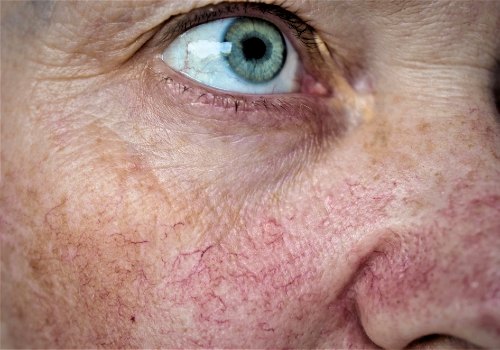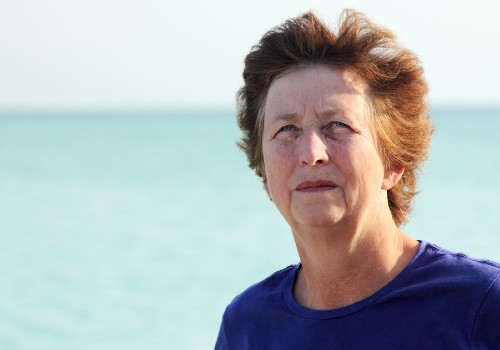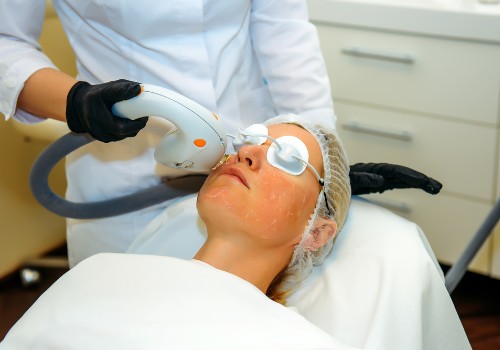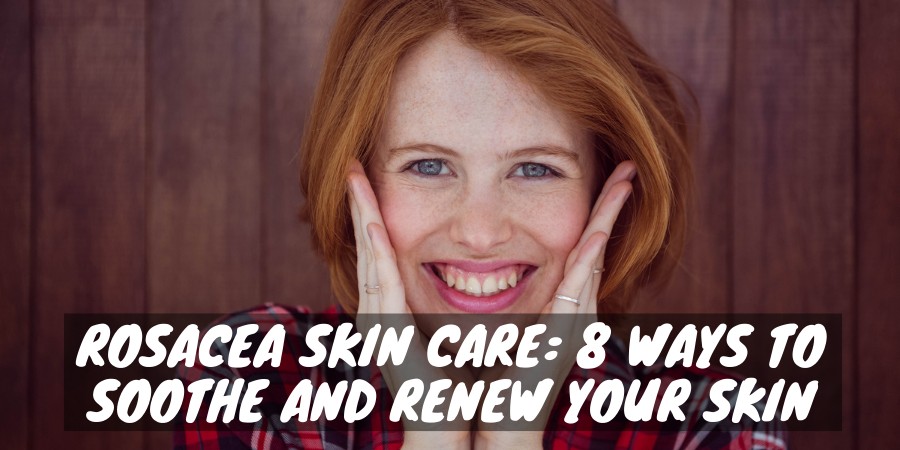If you have rosacea-prone skin, getting that perfect complexion can feel like an unattainable goal.
You don’t want to look like you’re sunburned for the rest of your life, but it seems like every skincare product on the market is designed to trigger a flare-up.
But you’re not alone in your struggles — and the path to clear, smooth, even skin is shorter than you might think!
Try these tips to beautify your skin without setting off your rosacea and get the complexion of your dreams.
Eight Essential Tips for Rosacea Skincare

Understand What Triggers Your Rosacea
Until you know what causes your rosacea to flare up, you’ll have a very hard time getting it under control.
Some of the most common rosacea triggers are sunlight, heat, stress, spicy foods, hot beverages, alcohol and hairspray.
Rosacea can also be a symptom of menopause, caffeine withdrawal, steroid use or anxiety.
Everyone’s rosacea triggers are different, so it’s important to monitor your condition and take note of your mood, body and surroundings during a flare-up. Identifying patterns in your flare-ups will help you isolate your biggest triggers.
Gently Cleanse Your Face Twice a Day
One of the biggest mistakes that people make when dealing with rosacea is using the wrong cleansing routine.
Most facial cleansers on the market are simply too harsh for those with rosacea. This can lead rosacea sufferers to wash their faces too infrequently.
Unfortunately, dirty skin is a common rosacea trigger. If you’re avoiding washing your face because of your rosacea, you could actually be making the problem worse.
Twice-daily cleansing is recommended for those with rosacea. The key is to use a gentle cleanser and a light hand to avoid setting your condition off.
Pick a cleanser that’s formulated for sensitive skin, apply it gently with clean fingers, then rinse it off thoroughly with lukewarm water. Do this once in the morning and once in the evening to keep your skin clean, clear and calm.
Moisturize Religiously
Rosacea can have many different effects on your skin, including making it extra oily.
This can make you want to skip moisturizing and let your skin dry out instead.
But restoring your moisture barrier with a moisturizer can actually decrease your oil production, thus reducing rosacea-related irritation.
Moisturizing also prevents symptoms of dryness, like flaking and itching, that often go hand-in-hand with rosacea.
Use a lightweight moisturizer formulated for sensitive skin in the morning and apply a richer one at night for best results.
Use Sun Protection Year Round

One of the most common rosacea triggers is the sun. In fact, even people without chronic rosacea can experience it after a day out in the sun.
Between the UV rays, the dryness and the heat, the sun is the worst enemy of those with rosacea. But you don’t need to lock yourself in a windowless basement for the rest of your life to avoid it.
Instead, start every day with a hearty dose of sun protection. Apply a broad spectrum, SPF 30+ sunscreen to your exposed skin every morning and reapply it every 2 hours throughout the day.
Chemical sunscreens can cause flare-ups, so go with a mineral sunscreen that contains zinc oxide and/or titanium dioxide. Try to pick one that contains hydrating silicones to further soothe your skin.
Even if it’s cloudy or wintry outside, you still need sunscreen — UV rays can penetrate through clouds, triggering your rosacea. And don’t think staying inside is a solid defense, either: most windows don’t block UV rays, so your skin will still be at risk.
Avoid Drying Skin Products
Skincare products that contain drying ingredients can irritate just about anyone’s skin.
But if you have rosacea, you need to be especially careful to avoid them.
Alcohols, sulfates, salicylic acid, sodium chloride and AHAs are just some of the drying ingredients found in many skincare products.
By leeching the water from your skin, these ingredients cause irritation and weaken your skin cells. That’s a recipe for a rosacea flare-up, even if you’re not exposed to any of your other triggers.
Instead, look for products formulated for dry, sensitive skin to minimize the risk of irritation.
Switch to Rosacea-Friendly Skincare Products
In addition to the drying ingredients listed above, you’ll also want to avoid several others if you have rosacea.
Fragrances are common triggers, so look for products that are labeled as fragrance-free. Note that this isn’t the same thing as unscented — products that are labeled as unscented can still contain fragrances.
Menthol lends a cooling sensation to cleansers and other products, but it can be highly irritating to those with rosacea.
Camphor is often touted as a cure for redness, but those with rosacea should stay away from it. It’s known to cause flare-ups despite its apparent suitability for rosacea.
When possible, use cream products rather than gels or lotions. Cream products tend to be more hydrating and less irritating than other types.
Finally, you might want to skip the toner stage of your skincare routine. Toner’s astringent properties can trigger rosacea flare-ups, especially those whose skin is already dry.
Always Patch Test New Products Before Using
Skincare in general is a game of trial-and-error, but that’s especially true for those with rosacea. Even products designed for sensitive skin can still set your rosacea off if you’re not careful.
That’s why you should always do a patch test of any new products or makeup before applying them to your face.
Apply a small amount of the product to an inconspicuous area of skin that’s close to (but not within) your rosacea-prone areas. Monitor the spot for 72 hours, and don’t use the product if you experience redness, burning, stinging or other adverse effects.
Be Gentle with Your Skin
Perhaps the most important rule of rosacea skincare is this: always be gentle.
Apply products with your fingertips in light, circular motions. Never use a washcloth, sponge or other applicator that rubs and tugs at your skin.
Avoid touching your face as much as possible, and if you must, do it as lightly as possible. Don’t rest your cheek in your hand, rub your eyes or otherwise exert undue pressure or friction on your skin.
And stay away from physical exfoliants — the particles in them drag on your skin, which can be highly irritating. When it’s time to exfoliate, use an enzyme exfoliant or a light BHA exfoliant to minimize the risk of a flare-up.
Professional Treatment Options for Rosacea
If you have persistent rosacea that’s preventing you from getting the best skincare, consider one of these professional treatments to greatly reduce your symptoms.
Laser Treatment for Rosacea

During laser treatment, a beam of highly-concentrated light at a special wavelength is directed at your skin.
The heat from the laser causes your surface-level blood vessels to shrink, reducing the redness that’s characteristic of rosacea. It also evens out rosacea-thickened skin and gets rid of the pustules that often accompany the condition.
Laser treatment typically requires multiple sessions and must be performed by a doctor. Side effects are typically minor and include temporary redness, discomfort and tightness.
Many people experience a 50% to 75% reduction in rosacea symptoms after completing laser treatment. And best of all, the results can last up to five years.
Chemical Peels for Rosacea
Chemical peels are high-powered exfoliants that remove the outer layer of your skin with a chemical solution. This also removes any surface-level imperfections, leaving behind a new, fresh layer of skin.
It sounds like the opposite of what you should do if you have rosacea. But if your rosacea is mild or moderate, and if your skin isn’t especially dry or sensitive, a chemical peel can actually relieve your rosacea symptoms.
A low concentration (20% to 40%) glycolic acid peel is recommended for rosacea treatment. This will remove redness and shrink your dilated blood vessels.
If you have rosacea, always consult a professional if you want a chemical peel. A doctor will be able to assess your individual risks and determine whether you’re a suitable candidate for a chemical peel.
Should you decide to get a chemical peel, you’ll likely need multiple sessions with two to four weeks of downtime in between each one. You may also need to care for your skin in between sessions with a glycolic acid cream or cleanser.

